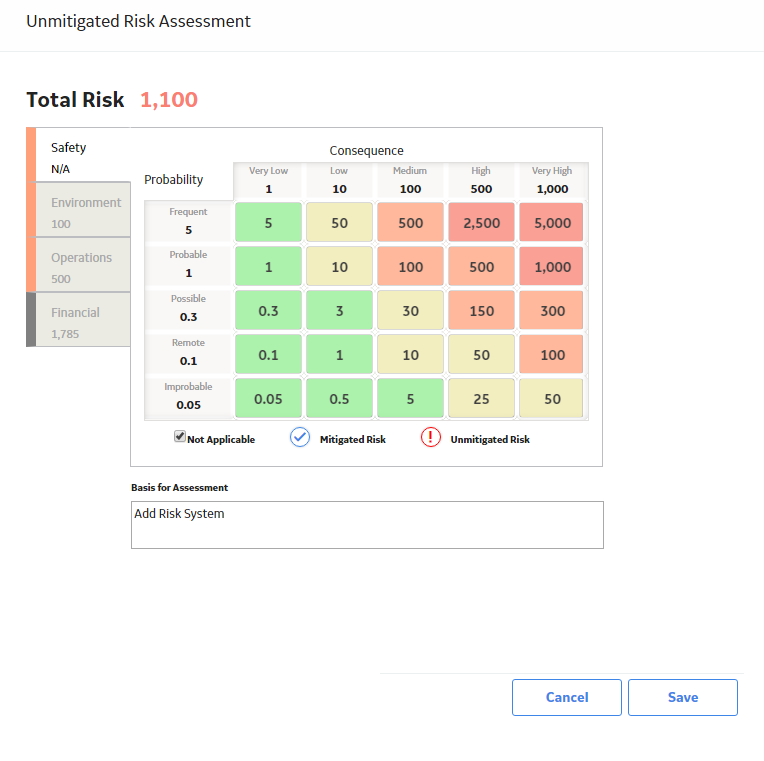Risk and Risk Assessment
About Risk and Risk Assessment
In Predix Essentials, risk is the combination of a harmful event or condition and its negative outcome. In addition to identifying risks, in Predix Essentials, you can also perform a risk assessment, which assesses:
- The probability that the negative outcome will have an impact on safety, the environment, operations, or finances.
- The severity of the safety, environmental, operational, or financial impact.
In some Predix Essentials modules, you will assess risk using the Risk Matrix. In other modules, you will assess risk using datasheets or other forms. Keep in mind that the type of impact that each module allows you to assess might differ. For example, Asset Strategy Optimization (ASO) allows you to assess safety, environmental, and operational impact. Asset Strategy Management (ASM), on the other hand, allows you to assess safety, environmental, operational, and financial impact.
More About Risk
In any company, equipment and locations can fail. In some cases, these failures do not cause any immediate problems. For instance, consider a clothes dryer with a switch that shuts off the dryer automatically if the temperature inside the drum reaches 180 degrees Fahrenheit (F). If the switch stops working but the temperature never reaches 180 degrees F, meaning that the switch is never activated, the switch failure would not present any problems.
In other cases, however, a failure can cause not only problematic but catastrophic consequences. Consider the same clothes dryer and safety switch. If the safety switch stops working and the temperature inside the drum does reach 180 degrees F, the switch will not perform its intended function: shutting off the dryer. Instead, the dryer would continue to run, allowing the temperature to potentially rise even further, which could ultimately cause the dryer to catch on fire.
From this example, you can see that the safety switch failure is problematic because it could cause a fire, which would have safety, financial, and operational impacts.
In Predix Essentials, a risk is the combination of a harmful event or condition and the negative outcome of that event or condition. In the example described above:
- The switch failure is the harmful event.
- A fire is the negative outcome.
So, the risk in this example is the combination of the switch failure and the negative outcome. In other words, the risk is that the switch stops working and the dryer overheats, eventually causing a fire.
To perform a risk assessment of this situation, you would consider:
- The probability that the fire will have a safety, environmental, operational, or financial impact. For example, you might determine that an operational impact is inevitable, while an environmental impact is possible but not likely.
- The severity of the safety, environmental, operational, or financial impact. For example, you might determine that the severity of a safety impact is very high (homeowners could be killed), but the severity of an environmental impact is low (damage only to immediate, surrounding landscaping).
Specify Risk Values to Determine an Overall Risk Rank
About This Task
You can use the Risk Assessment window to select values in various categories that will be used to determine an overall risk rank.
Procedure
Results
- When you are finished making selections on each tab, the values that appear next to each tab name (except for a financial tab) are used in a calculation to determine the overall risk rank.
- In the corresponding Risk Matrix record, if the Use Maximum Risk Rank check box is selected, the risk rank will equal the largest value on the tabs.
-or-
- In the corresponding Risk Matrix record, if the Use Maximum Risk Rank check box is not selected, the risk rank will equal the sum of values on each tab.
- In the corresponding Risk Matrix record, if the Use Maximum Risk Rank check box is selected, the risk rank will equal the largest value on the tabs.
- The calculated risk rank is displayed in either the Unmitigated Risk Rank section or the Mitigated Risk Rank section, depending on the type of risk you are working with.
The calculated risk rank is displayed in either the Unmitigated Risk Rank section or the Mitigated Risk Rank section, depending on the type of risk you are working with.
 icon will appear.
icon will appear. icon will appear.
icon will appear.